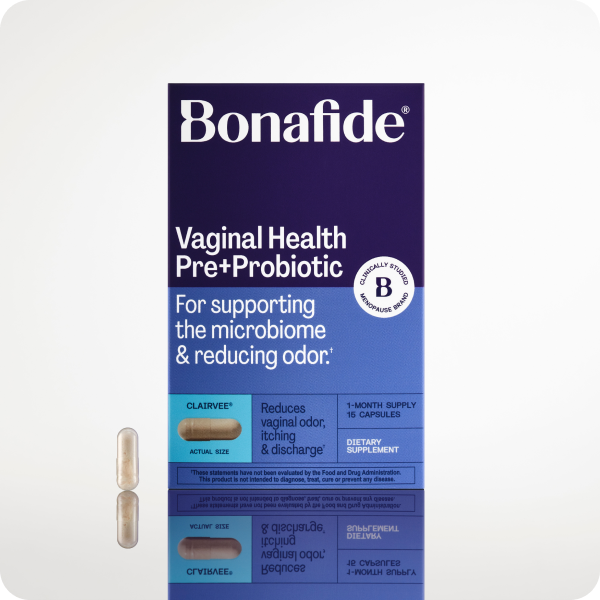The gut microbiome has been a popular topic over the past few years—but did you know that it’s not the only microbiome you have? Microbiomes are simply the ecosystems of microorganisms—including bacteria, fungi, protozoa, yeasts, and viruses—that live on and inside different parts of our bodies. And while most of them live in your gut, other parts of your body have their own unique microbiomes, including your vagina.
What is the Vaginal Microbiome?
The vaginal microbiome (also called the vaginal microbiota) is the collection of microorganisms, mostly bacteria, that are active in the vagina. Just like your gut microbiome can affect everything from weight to susceptibility to conditions like diabetes1 and irritable bowel syndrome2, the balance of microbes in the vaginal microbiome has been linked to a healthy reproductive system and beyond.3
In the gut, microbial diversity is typically a good thing. But in the vagina, a healthy vaginal microbiome is one that’s dominated by lactobacillus, a single genus of bacteria that creates a protective environment.4 The ideal healthy vaginal microbiome is made up of at least 90% lactobacillus bacteria5—but about a third of women don’t have this dominance in their vaginal microbiome, leaving them at an increased risk for more common symptoms such as discharge, odor, and itching.6 A lower level of vaginal lactobacillus, which can be common during perimenopause and menopause due to shifting hormones, can also make the vagina more susceptible to infections like yeast and bacterial vaginosis (BV), as well as the abovementioned related symptoms including odor, itching, and discharge.7
What Affects the Balance of the Vaginal Microbiome?
A better question might be: what doesn’t?
Research has found links between the vaginal microbiota in women and everyday factors like hormonal birth control, sexual activity, smoking, diet, stress, exercise, antibiotics, menstruation, and hormonal changes experienced during the menopausal transition. Products that promise to “clean” your vagina, like douches, can especially throw your vaginal microbiome off balance, actually causing symptoms like odor and itching.8
Your vaginal microbiome also changes throughout your whole life,9 but if you’ve been getting bacterial vaginosis or noticing symptoms like itching, odor, and discharge more frequently in your 40s, during perimenopause and beyond, you’re likely not imagining it.
Why Does the Vaginal Microbiome Change Over Time?
Research is preliminary and still developing, but scientific data shows a connection between the vaginal microbiome and vaginal health during perimenopause, menopause, and postmenopause. One influencing factor could be tied to the lower levels of estrogen experienced during this time. It’s also been found that the amount of vaginal lactobacillus increases during pregnancy and puberty, when your estrogen levels increase. But when your estrogen levels decline during perimenopause, menopause, and postmenopause, your vaginal lactobacillus levels decline too.10
That’s why it may feel like there’s a whole lot happening with your vagina starting in perimenopause—some of which can lead to discomfort. Lower levels of estrogen can change the vagina on a cellular level, causing menopausal vaginal atrophy—where vaginal tissue thins and becomes less elastic.
Genitourinary Syndrome of Menopause
Vaginal atrophy is part of what’s called genitourinary syndrome of menopause, also known as GSM, the umbrella term for genital symptoms (like dryness, burning, and irritation), sexual symptoms (like pain, lack of lubrication, and weaker orgasms) and urinary symptoms (like worse bladder control, painful urination, and recurring urinary tract infections).11
Genitourinary Syndrome of Menopause Treatment
Perimenopause alone lasts an average of four years, and postmenopause goes from your final period to, well, the rest of your life.12 That’s a long time to be experiencing the symptoms of GSM. Menopause symptoms, including GSM, often improve with estrogen-based hormone replacement therapy10 (which has been shown to restore lactobacillus levels), but it’s not your only option.
- Consider probiotics specifically designed for maintaining balance of the healthy vaginal microbiome. Probiotics formulated with live, active lactobacillus strains specific to the vagina, have been shown to help balance and maintain a healthy vaginal microbiome.13
- Making certain tweaks to your diet may also have a positive effect on reducing symptoms—One study suggests that low folate levels are associated with more severe bacterial vaginosis infections and that increased intake of vitamin E, and calcium may be associated with fewer bacterial vaginosis infections.14 Additionally, deficiencies of vitamin D could potentially be associated with increased risk of bacterial vaginosis, however further research is needed to verify this.15
- If you’re sexually active, consider using condoms with both female and male partners, if you’re not already—studies have shown that semen has its own microbes along with an alkaline pH, which can alter the vaginal microbiome.16 Additionally, microbes from the mouth can alter the vaginal microbiome during oral sex.17 Menopausal hormone changes can also shift your vaginal pH, so it’s a good idea to take a few extra precautions to maintain this delicate balance to prevent discomfort.
- If you need a reason to quit smoking, do it for your vagina. Clinical studies have shown that cigarette smokers are much more likely to have low lactobacillus levels, and that smoking can be associated with a higher risk of bacterial vaginosis and damage to cervical cells.18 Additionally, smoking has been shown to exacerbate other symptoms of menopause, such as hot flashes, so quitting may provide you with more than just one benefit.19
- Make sure to give probiotics and diet and lifestyle changes a chance to work by staying away from vaginal douches, heavily fragranced soaps, body washes or wipes, deodorants as well as scented detergents, and fabric softeners on undergarments. While it may be tempting to use these options to temporarily cover up the problem, these products can disrupt the balance of bacteria in your vagina, potentially setting back any progress you may have made toward balancing your vaginal microbiome.20
Resources
- https://www.sciencedirect.com/science/article/pii/S0955286318303073
- https://pubmed.ncbi.nlm.nih.gov/31789724/
- https://www.fredhutch.org/en/news/center-news/2015/04/lessons-about-vaginal-microbiome.html
- http://harvardmagazine.com/2021/07/features-balskus-human-microbiome
- https://www.abc.net.au/news/health/2017-11-22/vaginal-microbiome-why-it-is-important-for-womens-health/9176782
- https://www.wgbh.org/news/science-and-technology/2020/03/05/first-vaginal-microbiota-transplants-in-the-us-to-begin-at-mass-general-hospital
- https://www.frontiersin.org/articles/10.3389/fcimb.2021.686167/full
- https://www.ncbi.nlm.nih.gov/pmc/articles/PMC4458466/
- https://www.ncbi.nlm.nih.gov/pmc/articles/PMC6743080/
- https://journals.asm.org/doi/10.1128/msphere.00593-20
- https://www.ncbi.nlm.nih.gov/pmc/articles/PMC4561742/
- https://my.clevelandclinic.org/health/diseases/15224-menopause-perimenopause-and-postmenopause
- https://obgyn.onlinelibrary.wiley.com/doi/10.1111/1471-0528.15870
- https://pubmed.ncbi.nlm.nih.gov/17709453/
- https://www.massgeneral.org/obgyn/patient-resources/womens-health/faq-bacterial-vaginosis
- https://www.frontiersin.org/articles/10.3389/frph.2020.566559/full
- https://www.nature.com/articles/s41598-019-55929-7
- https://www.nature.com/articles/s41598-017-14943-3
- https://www.ncbi.nlm.nih.gov/pmc/articles/PMC2673540/#:~:text=One%20of%20the%20most%20common,never%20smoked%20cigarettes%20(2).
- https://www.apha.org/policies-and-advocacy/public-health-policy-statements/policy-database/2014/07/29/13/06/vaginal-douching-and-adverse-health-outcomes#:~:text=Douching%20alters%20the%20normal%20vaginal,up%20into%20the%20reproductive%20tract










